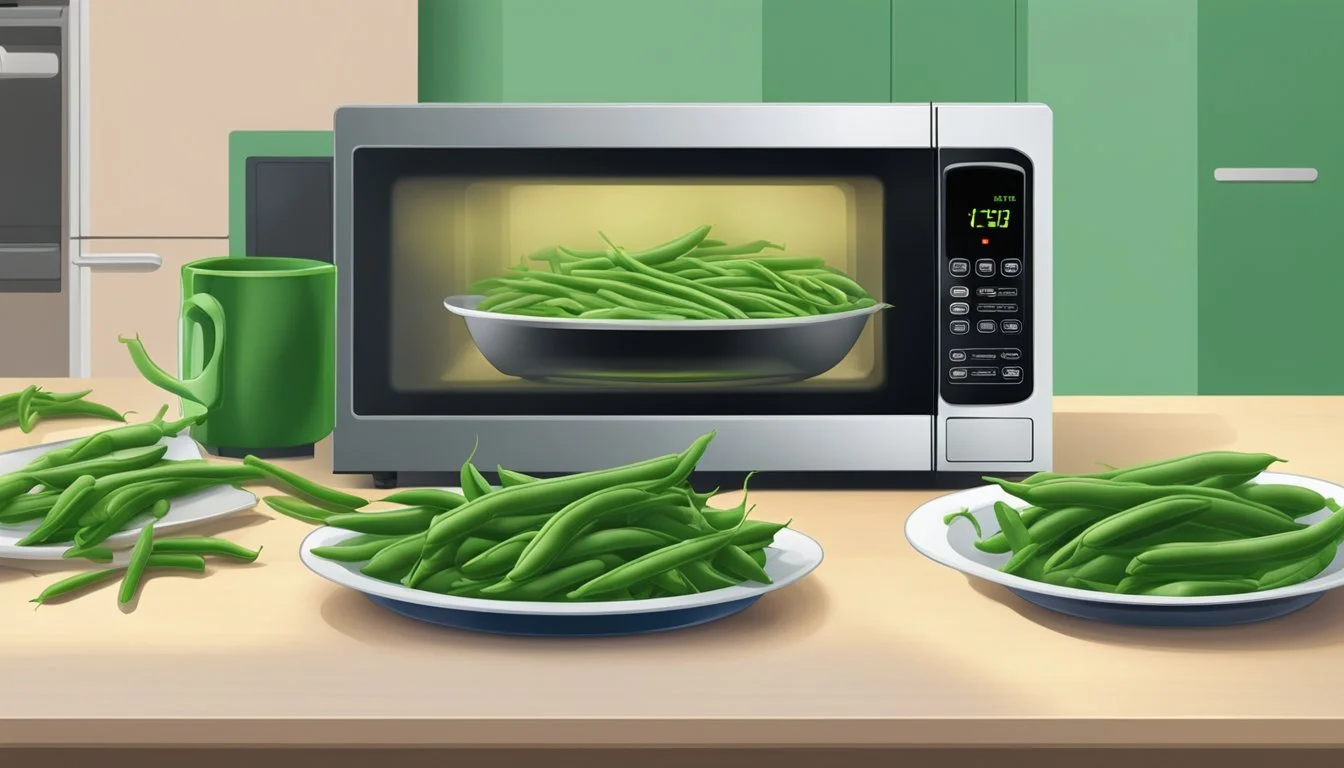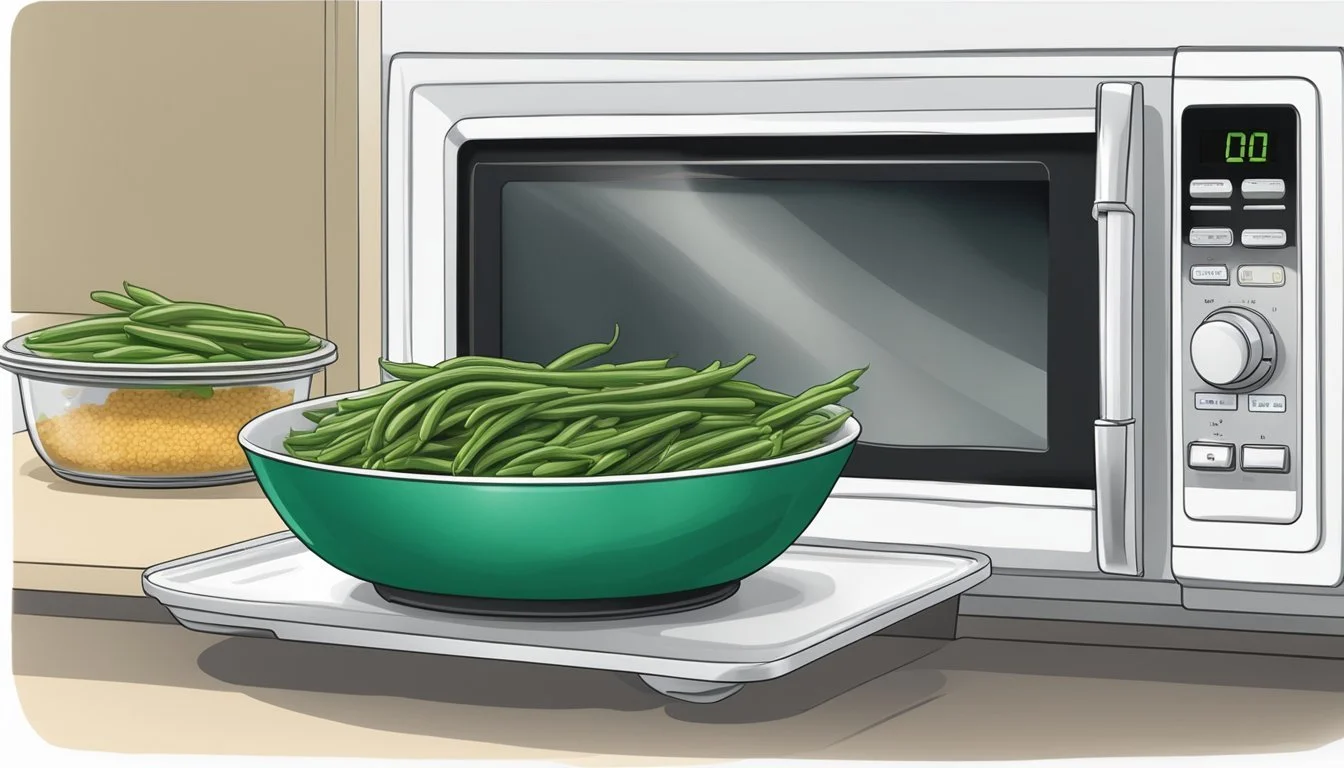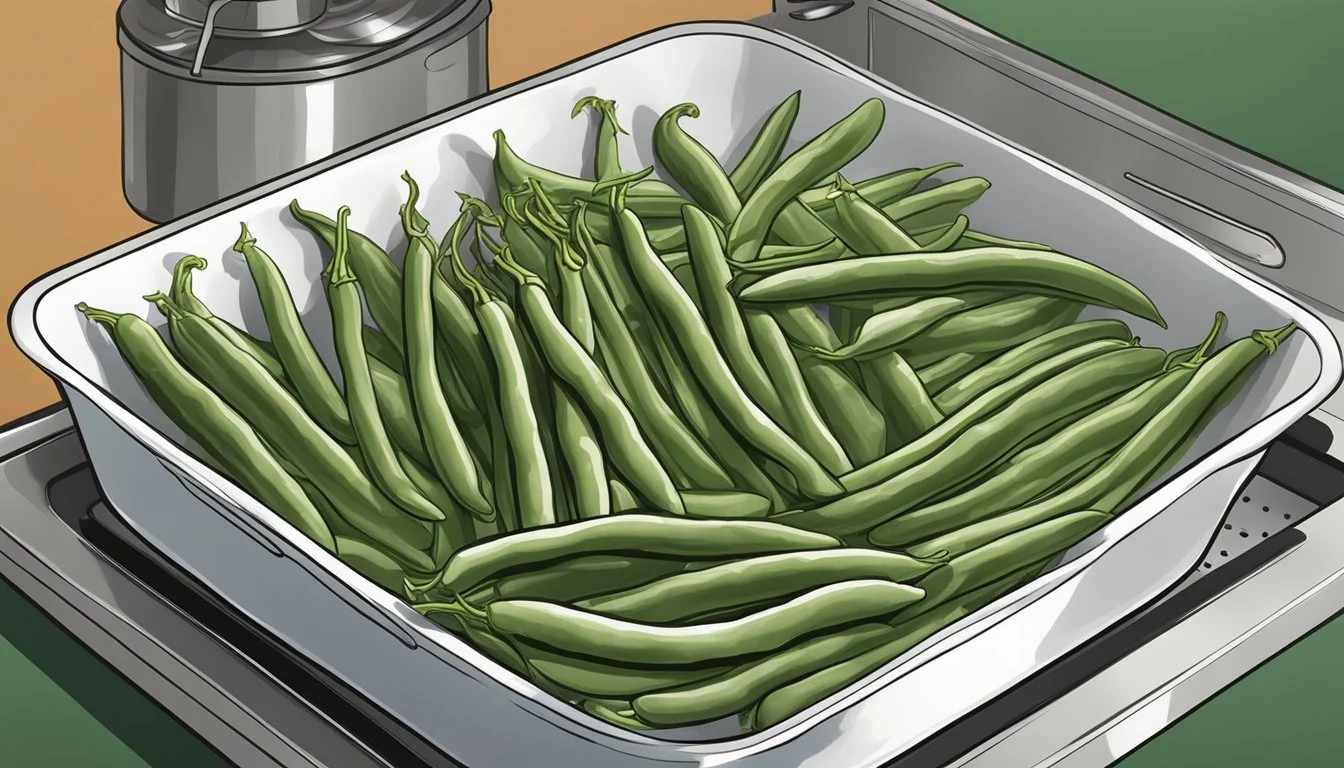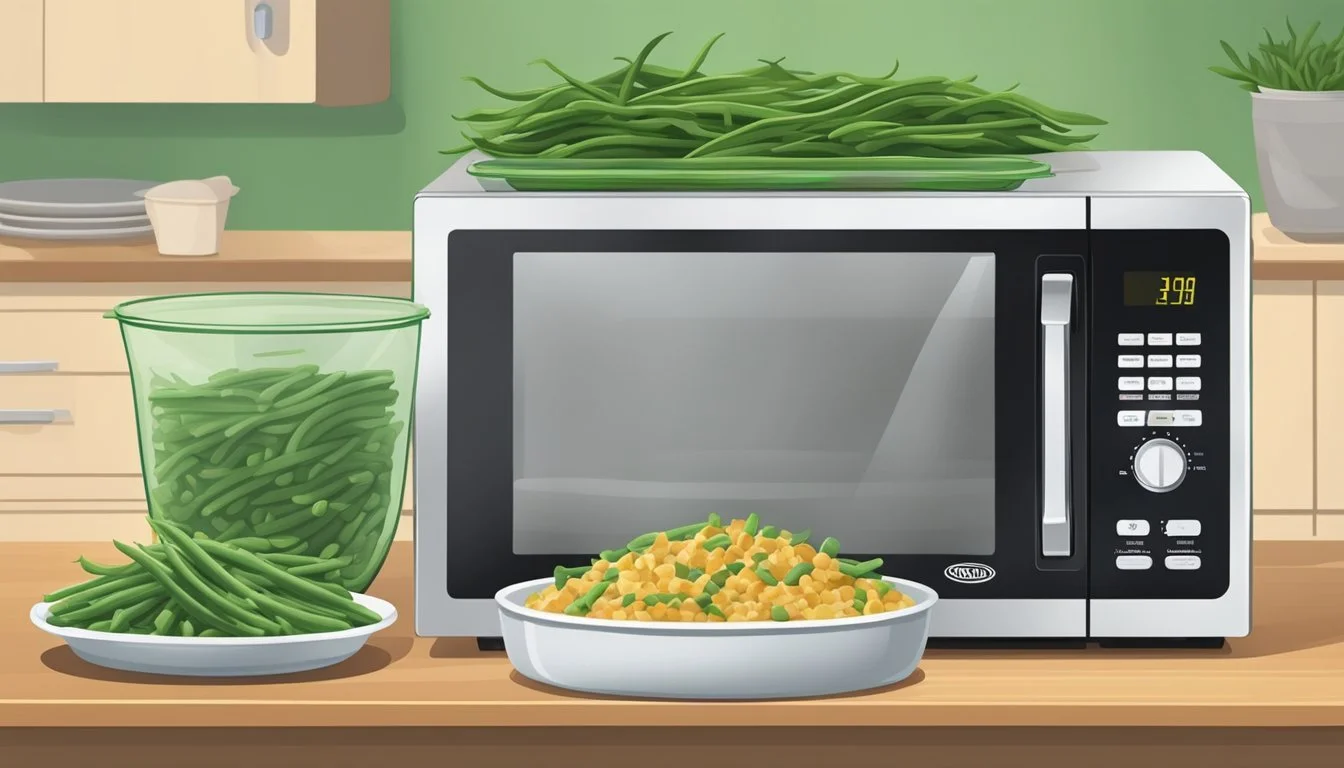How to Reheat Gluten-Free Green Beans for Perfect Texture
Reheating gluten-free green beans doesn't have to be a challenge, whether one is working with a homemade dish or leftovers from a grand feast. The key is to preserve their nutritional value while ensuring they taste fresh and delicious. To achieve perfectly reheated green beans, preheat the oven to 350°F, line a baking sheet with foil, and spread the green beans in a single layer.
For those enjoying gluten-free green bean casserole, layering the beans on a baking dish, adding a bit of water or broth, and covering it with foil ensures even heating. Baking for about 15 minutes retains the casserole's rich flavors and keeps it moist. This method enhances the dish's texture without compromising on its gluten-free integrity.
Opting for quick and easy methods, individuals can also use a microwave. Placing green beans on a microwave-safe dish and reheating in 30-second intervals, stirring between each, ensures even heating without losing nutrients. This versatile approach caters to those with time constraints while maintaining the dish's healthy profile.
Understanding Gluten-Free Green Beans
Green beans are a versatile side dish enjoyed by many. For those following a gluten-free diet, it's essential to understand the different varieties and their benefits.
Differentiating Green Bean Varieties
Green beans come in various forms including fresh, canned, and frozen.
Fresh green beans are often preferred for their crisp texture and vibrant color. They are available in two main types: string beans and snap beans. String beans have a fibrous string along their seam that needs to be removed, while snap beans do not.
Canned green beans are pre-cooked and typically stored in a brine solution. They are convenient and quick to prepare but may contain added salt or preservatives, so checking labels is crucial.
Frozen green beans are flash-frozen at their peak ripeness to preserve flavor and nutrition. They offer a good balance between convenience and freshness. Unlike canned, they usually contain no added ingredients, making them an excellent gluten-free option.
Benefits of Gluten-Free Green Bean Side Dish
A gluten-free green bean side dish offers several nutritional benefits. Green beans are naturally low in calories and rich in vitamins A and C, which are beneficial for immune function and skin health. They also provide a good source of dietary fiber, aiding in digestion and maintaining a healthy gut.
For those following a vegan diet, green beans are an excellent protein source when paired with complementary foods like nuts or seeds. They can easily be incorporated into various recipes without compromising on taste or texture.
Moreover, green beans do not naturally contain gluten, making them suitable for those with celiac disease or gluten intolerance. They can be seasoned and prepared in numerous ways, ensuring that dietary restrictions do not limit meal variety and enjoyment.
Preparation Tips Before Reheating
Ensuring the freshness and crispness of gluten-free green beans involves proper storage, adequate preparation, and precise trimming and cleaning methods.
Proper Storage for Freshness
Store gluten-free green beans in an airtight container in the refrigerator.
Storing green beans correctly ensures they remain fresh and crisp. It's crucial to refrigerate them immediately after purchase. Utilize airtight containers to prevent moisture loss and contamination. For longer storage, consider blanching the green beans before refrigeration.
To blanch, boil green beans for 2-3 minutes until bright green, then quickly cool them in an ice water bath. This stops the cooking process and helps maintain their vibrant color and texture.
Prep Time and Cook Time Essentials
Preparation and cooking times directly impact the texture and flavor of reheated green beans.
Estimate the prep time for reheating green beans to be about 5-10 minutes. This includes gathering and preparing all necessary ingredients and utensils. The cook time in the oven typically ranges from 10-15 minutes at 350°F (175°C).
Preheating the oven is essential to achieve an even temperature. Spreading the green beans in a single layer on an oven-safe dish or a baking sheet lined with aluminum foil ensures consistent cooking.
Trimming and Cleaning Guidelines
Thorough cleaning and proper trimming enhance the quality of reheated green beans.
Start by washing green beans under cold water to remove any dirt or debris. Use a colander for an efficient wash. Trim the ends with a sharp knife or kitchen scissors, ensuring to remove any tough or fibrous parts.
If reheating involves whole beans, keep them intact. For a different texture, slice or chop the green beans into smaller pieces. This can slightly reduce reheating cook time and promote even heating.
Maintaining cleanliness in your kitchen workspace is equally important to avoid contamination and ensure the green beans remain as fresh and healthy as possible.
Reheating Techniques and Tips
To reheat gluten-free green beans while ensuring they stay flavorful and textured, consider the following techniques. Each method offers unique benefits suited to different needs and preferences.
Microwaving for Convenience
For a quick and easy option, the microwave is ideal. Place the green beans on a microwave-safe dish in a single layer.
Cover the dish with a microwave-safe lid or wrap it with plastic wrap. Set the microwave to high and heat the green beans in 30-second intervals, stirring gently between each interval.
Check for doneness after each interval to avoid overcooking. The green beans should be evenly heated and retain their original texture and taste.
Oven-Baking for Even Warmth
Oven-baking is perfect for achieving uniform warmth. Preheat the oven to 350°F (175°C) and line a baking sheet with aluminum foil.
Spread the green beans in a single layer on the baking sheet. Sprinkle with salt and pepper, if desired.
Bake for 15 minutes or until the green beans are heated through and fork-tender. Use oven mitts or heat-resistant gloves to remove the baking sheet safely.
Stovetop Sautéing for Crisp Texture
Sautéing in a skillet offers a crisp texture. Heat a tablespoon of olive oil or butter in a large nonstick skillet over medium heat.
Add the green beans to the skillet and toss them gently to coat with oil. Sauté for 5-7 minutes, stirring occasionally, until the green beans are evenly heated and crisp-tender.
Adjust seasoning with salt and pepper as needed. This method brings out a slightly caramelized flavor in the green beans.
Using an Air-Fryer for Crunchiness
The air-fryer provides a crunchy texture. Preheat the air-fryer to 375°F (190°C). Place the green beans in the air-fryer basket in a single layer.
Cook for 5-7 minutes, shaking the basket halfway through the cooking time. Check for doneness to ensure they are crispy but not overcooked.
This method is excellent for preserving the freshness and crunchiness of the green beans while reheating them.
Gluten-Free Green Bean Casserole Reheating Guide
To bring back the cozy flavors of your gluten-free green bean casserole, focus on two essentials: crafting a luxurious cream of mushroom sauce and ensuring your crispy fried onions stay delightfully crunchy.
Creating a Creamy Mushroom Sauce
Start by melting butter in a saucepan, which forms the base of your sauce. To thicken it, whisk in gluten-free all-purpose flour until smooth. This blend creates a roux, crucial for a creamy texture.
Gradually add almond milk if dairy-free, or any preferred milk. Stir continuously to keep the mixture lump-free. For rich flavor, mix in homemade or store-bought gluten-free cream of mushroom soup, then season with kosher salt and black pepper.
The sauce should gently simmer until it thickens to a creamy consistency. Flavor it with additional spices like thyme or black pepper if desired, and fold it into your green beans to give the casserole its signature creaminess.
Maintaining the Crunch of Crispy Fried Onions
Preheat your oven to 350°F (180°C) for consistent heat. While the oven warms, allow the casserole to reach room temperature. To maintain the crunch of your gluten-free French fried onions, reheat with care.
Cover the casserole with foil to keep moisture in but avoid making it soggy. Bake for 15-30 minutes, removing the foil in the last few minutes to crisp up the fried onions. This step ensures they remain crispy despite the reheating process.
Remember, if you prefer air frying, set the air fryer to 375°F. Place the casserole in a heat-safe dish and cook for 6-8 minutes, stirring halfway through. This method is effective for keeping the crispy fried onions crunchy and the casserole warm.
Customizing Your Side Dish
Personalizing your gluten-free green beans can make the dish more appealing and suited to different dietary needs while adding a unique touch. Through careful ingredient selection and cooking techniques, you can adapt the green beans to various preferences.
Adapting to Dietary Requirements
For those requiring dairy-free options, substitute traditional dairy ingredients with coconut milk or olive oil. Coconut milk provides a creamy texture without the lactose, while olive oil offers a lighter alternative with a subtle, rich flavor.
Vegan adaptations can be easily achieved by removing any animal products. Use vegan butter or olive oil in place of dairy butter and vegetable broth instead of chicken broth to maintain a full, savory taste.
People with gluten-free needs should ensure all seasonings and broths are certified gluten-free. Even small amounts of gluten can cause reactions in those with celiac disease or gluten sensitivity. Tamari can be a gluten-free substitute for soy sauce.
Incorporating Flavor Enhancers
Add depth by including herbs such as thyme and oregano. These herbs bring out the natural flavors without overpowering the dish.
For a richer taste, blend in chicken broth or for a non-dairy creamy texture, add heavy cream or coconut milk. Seasoning with sea salt and black pepper is essential.
Incorporate bacon for an indulgent flavor boost. Crispy, caramelized shallots or onions also add a sweet and savory element. Small amounts of lemon zest or garlic can freshen and elevate the flavor profile.
Adding Textural Contrasts
Integrate crunchy toppings like toasted nuts or seeds for an interesting texture contrast.
Crispy bacon bits can provide a satisfying crunch and a smoky flavor.
Consider adding fried onions or caramelized shallots to introduce a crispy exterior with a tender, sweet interior.
For additional heartiness, toss in some sautéed mushrooms or chunks of potatoes. This adds both texture and complexity, making the side dish more substantial.
Experimenting with different textural elements can create a more enjoyable and multi-dimensional eating experience for all.
Serving and Presentation
Presenting reheated gluten-free green beans is key to enhancing their appeal, whether for a holiday feast or an everyday meal.
Serving Suggestions for Holidays
For Thanksgiving or Christmas, garnishing green beans with toasted almonds or crispy fried onions adds texture and flavor. Using a large, decorative platter enhances the visual appeal. A sprinkle of fresh herbs, such as parsley or thyme, increases the festive look and aroma. It's effective to place the platter in the center of the table, surrounded by other traditional dishes.
Serving utensils should be close by, so guests can easily help themselves. To keep the green beans warm throughout the meal, consider using a chafing dish. This method ensures that the beans remain appealing and at an ideal temperature.
Accompaniments for the Main Meal
Green beans pair well with various side dishes, complementing a range of flavors and textures. They work wonderfully alongside mashed potatoes and sweet potato casserole, providing a crisp contrast to these creamy dishes. Additionally, they balance the sweetness of orange cranberry sauce.
When combined with protein-rich mains, like roasted turkey or baked ham, green beans offer a fresh, light counterpart. For a gluten-free meal, ensure all accompaniments are free from gluten-containing ingredients. Employ simple seasonings, such as olive oil, salt, and pepper, to maintain a cohesive and enjoyable meal experience.
Ensuring Safe Consumption
When reheating gluten-free green beans, it is essential to be mindful of food safety practices to avoid any health risks. Recognizing signs of spoilage and reheating to the correct temperature are critical to ensuring safe consumption.
Recognizing Signs of Spoilage
The first step in ensuring that green beans are safe to eat is to identify any signs of spoilage. Spoiled green beans may display an off-putting odor, often sour or musty.
Visual indicators include slimy texture or discoloration, particularly patches of black or brown. Be vigilant for mold growth, as this is a clear sign the beans are no longer safe to eat.
Check the storage conditions as well. Leftovers should be stored in an airtight container and kept in the refrigerator at 40°F (4°C) or below. If green beans have been left at room temperature for more than two hours, they should be discarded to prevent the risk of foodborne illness.
Proper Reheating Temperatures
Reheating green beans to the right temperature is just as important as recognizing spoilage. The internal temperature should reach at least 165°F (74°C) to ensure any harmful bacteria are destroyed.
When using an oven, preheat it to 350°F (180°C). Place green beans in a baking dish, add a small amount of broth or water to maintain moisture, cover with foil, and bake for 10-15 minutes until they reach the safe temperature.
If opting for the microwave, spread the green beans evenly in a microwave-safe dish. Heat on high in 30-second intervals, stirring in between, until they reach the safe temperature of 165°F (74°C).
By following these guidelines, one can safely enjoy gluten-free green beans as part of a meal without compromising on health.
Collaborating with Other Festive Foods
Gluten-free green beans can enhance any festive meal by complementing traditional holiday recipes. This harmonious combination ensures that your holiday table is both inclusive and delicious.
Green Bean Casserole and Traditional Holiday Meals
Green bean casserole is a comforting classic often found on holiday tables, especially at Thanksgiving. By preparing a gluten-free version, you provide a delicious, inclusive option for guests.
Pairing gluten-free green bean casserole with other Thanksgiving sides like mashed potatoes, cranberry sauce, and stuffing creates a well-rounded meal. Its creamy texture and savory flavors blend seamlessly with these traditional dishes.
Incorporating this gluten-free dish with turkey allows for a balanced holiday spread. It ensures that all guests can enjoy a hearty, festive meal without worrying about dietary restrictions.








